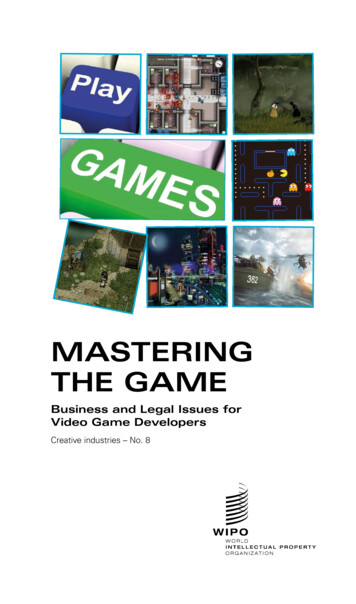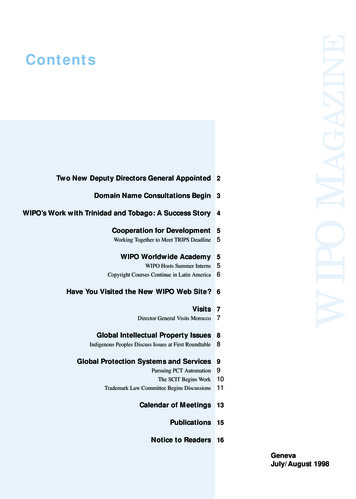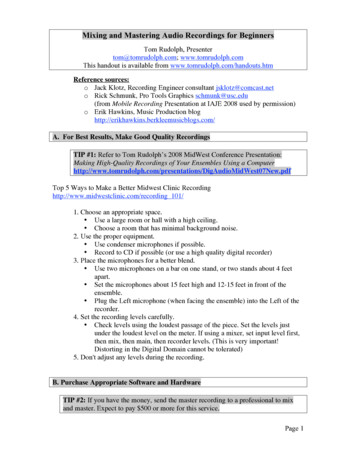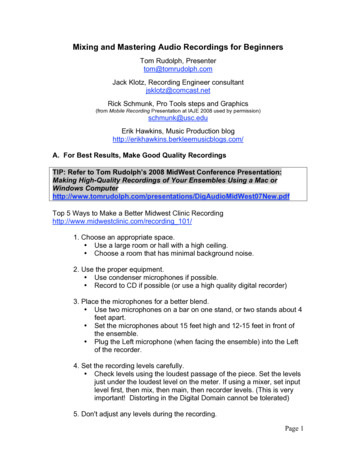
Transcription
Total width of maze blue lines should not exceed 224 pixelsTotal height including characters should not exceed 288 pixels (upper text may vary)NOTICE:ACTION SCENE 4(DRAMATIC SCENE)- Please use this version as a reference for accurate position of characters when developing artwork based on the Pac-man 80s Arcade Game- In addition, note that text/titles do not need to follow any exact position or pixel size and that the examples above are style references.- Character artwork shall not exceed 16pixels x 16pixels.- Black areas should exist surrounding the maze. NAMCO BANDAI Games Inc.MASTERINGTHE GAMEBusiness and Legal Issues forVideo Game DevelopersCreative industries – No. 8Maze.Last version: S/S 2012
By David GreenspanWith contributions fromS. Gregory Boyd,Jas PurewalandMatthew DatumCredits for Cover Screenshots:Image (top left) courtesy of Stuart Miles / FreeDigitalPhotos.netPrison Architect (top middle), Introversion Software Ltd.Thralled (top right), Miguel OliveiraImage (middle left and used on every odd page) courtesy of Stuart Miles / FreeDigitalPhotos.netPAC-MAN (middle right) TM & NAMCO BANDAI Games Inc.To The Moon (lower left), Freebird Games Inc.Battlefield and SimCity (lower middle and right), EA
3Mastering the GameTABLE OF CONTENTSList of Figures10List of Tables10List of Boxes10About the Authors11Preface13Executive Summary15Chapter 118The Global Structure of the Video Game Industry181.1 The Current Video Game Industry Landscape181.1.1Console Manufacturers191.1.2Digital Distributors191.1.3Mobile211.1.4Major Companies211.1.4.1First Party211.1.4.2Console and PC publishers231.1.4.3Mobile publishers231.2 The Changing Landscape of the Video Game Industry241.2.1End of Life Economics251.2.2Future Consoles271.2.3Rise of Digital Distribution281.2.4Rise of Mobile Gaming281.2.5Rise of Free-to-Play and other Monetization Schemes291.2.6Legal Challenges Created by Innovation301.3 Impact of the Changing Landscape and its Effects onGame Development321.4 The Role of the Publisher331.4.1Funding331.4.2Quality Assurance (QA) and Submission331.4.3Retail Distribution351.4.4Marketing351.4.5Worldwide Reach36
Business and Legal Issues for Video Game Developers4Chapter 237Dealing with Video Game Publishers372.1 The Role of the Publisher372.1.1Developer’s Concerns When Considering a Publisher382.1.2Publisher’s Concerns When Considering a Developer382.2 The Publishing Agreement392.2.1The Long Form Agreement: Introduction392.2.2Ownership Issues402.2.3Rights Granted412.2.4Additional Rights Issues: Right of First Negotiation and Last Refusalon Future �s Services; Delivery452.2.8Financials472.2.9Additional Royalty Issues and Payments512.2.10Accounting and Statements522.2.11Audit Rights532.2.11.1 Parameters for Audits532.2.11.2 Contesting a Statement542.2.11.3 Costs of Audits552.2.12Publisher Commitments552.2.13Representations and 602.2.16Credits612.2.17Termination for Cause and Convenience: Remedies622.2.18Governing Law and Jurisdiction642.2.19Dispute Resolution652.2.20Additional Provisions662.2.21A Changing Role662.3 SCENARIO 1: Questions for the Developer when the Publisher Ownsthe IP to the Game2.4 SCENARIO 2: Questions for a Distribution Agreement Only67692.5 SCENARIO 3: Publisher Helps Finance a Game Based onDeveloper’s Concept71
5Mastering the GameChapter 372Intellectual Property in the Videogame Industry723.1 The Importance of Intellectual Property723.1.1Copyright733.1.1.1What Can Be Protected By Copyright?743.1.1.2What Rights Are Conferred by Copyright?753.1.1.3Some Examples of Copyrights763.1.1.4US Copyright Filing Information763.1.1.4.1Process and Cost773.1.1.4.2Length of Copyright Protection773.1.1.4.3Protecting Copyright773.1.1.4.4Penalties for Infringement783.1.23.1.33.1.1.5Derivative Works793.1.1.6The Public Domain803.1.1.7Scènes à faire Doctrine823.1.1.8Fair Use823.1.1.9Common Questions about Copyright83Trade Secret843.1.2.1What Can Be a Trade Secret?843.1.2.2What Rights Are Conferred by Trade Secrets?853.1.2.3Examples of Trade Secrets853.1.2.4Trade Secret Information863.1.2.4.186Length of Protection3.1.2.4.2 Process and Cost863.1.2.4.3 Protecting Trade Secrets863.1.2.4.4 Penalties for Infringement873.1.2.5Trade Secret is State Law in the US873.1.2.6Common Questions about Trade Secrets88Trademark883.1.3.1What Can Be Trademarked?893.1.3.2Examples of Trademarks893.1.3.3Trademark Information903.1.3.3.1 Length of Protection903.1.3.3.2 Process and Cost in the US903.1.3.3.3 Protecting Trademarks913.1.3.3.4 Penalties for Infringement91
Business and Legal Issues for Video Game Developers63.1.43.1.3.4Picking a Good Trademark913.1.3.5Notable International Variation933.1.3.6Common Questions about Trademarks93Patents943.1.4.1What Can be Patented?953.1.4.2What Rights are Conferred by Patents?953.1.4.3Patent Information953.1.4.3.1 Length of Protection963.1.4.3.2 Process and Cost in the US963.1.4.3.3 Protecting Patents983.1.4.3.4 Patent Litigation and Penalties for Infringing Patents983.1.4.4US Patent Pending and Provisional Patent Applications983.1.4.5Patent Invalidity993.1.4.5.1 Anticipation and Obviousness993.1.4.5.2 Timing a Patent Filing1003.1.4.5.3 Reasons to File a Patent Application1003.1.4.5.4 Common Questions about Patents1013.1.5Rights of Publicity and Moral Rights1013.1.6IP Strategy 1011043.1.6.1Have a Relationship with Experienced IP Counsel1043.1.6.2Protect IP in Advance1043.1.6.3Protecting IP when Pitching a Game to Publishers and Investors1043.1.6.4The Process is Complex, but Results are Achievable1053.1.6.5Strategies for Small Companies and Individual developers1053.1.6.6Strategies for Large Developers and Publishers1063.1.7Three Important Points106Chapter 4108Licensing IP for Games1084.1 Introduction1084.2 The Licensing Agreement: The Long Form Agreement1104.3 The Major Issues in Licensing Agreements1114.3.1The Licensed Property1114.3.2Rights Granted1134.3.3Platforms1154.3.4Territory and Term1164.3.5Licensing Fee117
7Mastering the Game4.3.6Ownership Issues1204.3.7Statements and Audits1214.3.8Representations and s1264.3.11Termination Rights1284.3.12Expiration of the Agreement1314.3.13Miscellaneous Provisions1314.4Licensing Properties: Back to the Future131Chapter 5132Music1325.1 Introduction1325.1.1Hiring a Composer1325.1.2Licensing Music: Master and Synchronization Rights1335.1.3Licensing Music from Music Libraries1355.1.4Public Domain Music1355.1.5Anticipating Costs135 Chapter 6137Issues Dealing with the ConsolePlatform Manufacturers1376.1 Introduction1376.2 Approving Publishers and Developers; Agreements1376.3 Development and Manufacturing Issues1406.3.1140The Submission and Approval Process6.4 Business Issues1426.5Legal Issues1436.5.1Representations and Warranties; Indemnification, Limitation on 1456.5.4Term and Termination1466.5.5Choice of Law; Venue1476.6 Moving Forward147Chapter 7148Digital Distribution1487.1148PC Digital Distribution Introduction7.2 The Long Form Agreement: Introduction148
Business and Legal Issues for Video Game Developers87.2.1Rights Granted1497.2.2Delivery of Materials1497.2.3Continuing Obligations1507.2.4Term1517.2.5Marketing Issues1517.2.6Revenue Share and Pricing1527.2.7Statements and Audits1547.2.8Termination1547.2.9Limitation of Liability1567.2.10Assignment1567.2.11Other Terms157Chapter 8159The Mobile Gaming Market1598.1 Introduction1598.2 Dealing with Distributors (the ‘App Store’)1608.3 The Publisher – Developer Relationship1618.4 The End-User Monetization Models1638.5 Regulatory Considerations1648.6 Tax1658.7 IP Considerations1668.8 Compliance with Mobile Platform Rules1678.9 Moving Forward: The Constantly Changing Landscape167Chapter 9169The Regulation of the Game Industry1699.1 Introduction1699.2 Data Privacy1699.3 Consumer Protection1719.4 Advertising and Marketing1739.5 Other Regulation1749.6 Ratings1749.6.1Age Ratings and Content Descriptors1749.6.2Factors in Rating a Game1789.6.3Submissions and Review1799.6.4Ratings for Online Games1809.6.5Ratings for Mobile Devices181
9Mastering the GameChapter 10183Confidentiality Agreements18310.1 The Purpose of Confidentiality Agreements18310.2 The Major Issues in a Confidentiality Agreement18410.3 The Major Terms in the Confidentiality Agreement18510.3.1Preamble18510.3.2What is Confidential? Exclusions; Permitted Uses of Confidential Information 18610.3.3Level of Care and Length of Term18710.3.4Breach; Injunctive Relief18810.3.5No License Agreement18810.3.6Additional Terms18910.4 Deal Memos: Purpose and Potential Problems189Chapter 11192Common Clauses in Agreements19211.1 Common Clauses in Agreements19211.1.1Jurisdictional Issues19211.1.2Waiver19311.1.3No Joint 411.1.6Survival19411.1.7Notices19511.1.8Entire Agreement; Revisions19511.1.9Reserved Rights19611.1.10Force Majeure196Appendix197Sample Milestone Schedule for a Console Game197Acknowledgements198Bibliography200Legal and Business Book References200Books about the Video Game Industry and Video Games201Online Resources202Sources of Further Information on Chapter 3202Endnotes203
Business and Legal Issues for Video Game Developers10List of FiguresFigure 1:Sales of Consoles (as Percentage of Total Units) 201320Figure 2:Total Console Sales (12 Month Moving Average)26Figure 3:Console Development Process46Figure 4:Revenue Share49Figure 5:Mobile App Consumption159Figure 6:The Mobile Development Process162List of TablesTable 1:Major Publishers24Table 2:A Sample of Mobile Publishers24Table 3:Game Project and IP Law73Table 4:The Gasaway Chart80Table 5:Four Conditions to meet for Fair Use83Table 6:Trademark Strength and Categories92Table 7:IP Rights in the Video Game Industry107Table 8:Possible ways to earn money at different stages of gameplay164Table 9:The Pan European Game Information (PEGI) Ratings175Table 10:PEGI Content Descriptors176Table 11:The Entertainment Software Rating Board (ESRB) Rating Categoriesand Content Descriptors177List of BoxesBox 1:Three categories of video games18Box 2:The Simpsons: Tapped Out30Box 3:Movie Licenses109Box 4:Licensing hypothetical113Box 5:Traditional Retail Channel153Box 6:How does the European Union legal system work?174
Mastering the GameAbout the AuthorsDavid Greenspan has been involved in the video game industry for over 15 years,serving as the Director of Legal and Business Affairs for some of the most significantvideo game publishers at the time in the industry, including Sony/989 Studios, adivision of Sony Computer Entertainment America Inc., and THQ Inc. He currentlyworks as the Senior Director of Legal and Business Affairs for Namco Bandai GamesAmerica and is an Adjunct Professor at Santa Clara University School of Law, wherehe teaches a class in entertainment transactions. He has worked on the day-to-daybusiness and legal issues of more than 100 video games and has been involved in allaspects of video game development, publishing, licensing, distribution, and marketingand has negotiated hundreds of agreements covering these areas. Mr. Greenspan hastaught classes covering entertainment law, licensing and video games with a primaryfocus on transactional issues at Santa Clara University School of Law, PepperdineLaw School and Hastings Law School. He was perhaps the first person to teach thelegal and business issues of the video game industry at the university level, whenhe taught classes in this area at UCLA Extension from 1996-2000. Although he isterrible at playing games, he was able to negotiate a favorable royalty rate one time bydefeating a licensor’s lawyer in a sports video game.S. Gregory Boyd is a partner at Frankfurt Kurnit Klein & Selz and the Chairman ofthe firm’s Interactive Entertainment Group. Mr. Boyd has extensive experience ofnegotiating and drafting game development agreements for consoles, PCs, mobilegames, social games, online games, and MMOs. He negotiates, structures, anddrafts IP licensing, development, and employment agreements for multiple gamesand high technology media publishers and developers. Mr. Boyd is co-author andeditor of Business and Legal Primer for Game Development (Charles River Media)and serves as an Adjunct Professor at New York Law School. He is frequentlyquoted in Gamasutra, Edge-Online, CNN, Fortune, Forbes, and the New York LawJournal. Mr. Boyd has his JD and MD degrees from the University of North Carolina(Chancellor’s Scholar with honors, 2004). He also has an MBA from the NYU-SternSchool of Business (2009), and is a graduate of East Carolina University (MS 1998,BS magna cum laude, 1996). He is admitted to practice law in New York and is aregistered patent attorney with the USPTO.Jas Purewal is an interactive entertainment lawyer at Osborne Clarke in London. Headvises a wide range of interactive entertainment companies, from global publishersto innovative development studios, on all legal and business aspects of developing,publishing and financing games and other interactive entertainment in Europe.Mr. Purewal has written, lectured and been quoted extensively on developmentsin the industry. He writes Gamer/Law (www.gamerlaw.co.uk) one of the leadingblogs on interactive entertainment law. He also teaches interactive entertainment11
12Business and Legal Issues for Video Game Developerslaw and business at several universities and the UK’s National Film and TV School.Mr. Purewal was educated at the University of Nottingham and is admitted to practiceas a solicitor in England and Wales. He has been a lifelong gamer and technologyenthusiast since his father bought him his first computer at the age of about 8yrs old.Matthew Datum is an Associate Attorney at Namco Bandai Games America. Hereceived his J.D., cum laude, from the Santa Clara University School of Law and hisMBA from the Santa Clara University Leavey School of Business. A lifelong gamer,Mr. Datum is fluent in Japanese and has a large collection of Japanese RPGs.
Mastering the GamePrefaceToday the video game industry is rivaling the size of the motion picture industry andsurpassing the music industry in terms of overall revenue. Unlike the film industry,which has a hundred year old history from the late 1880s, the video game industryhas perhaps become the fastest growing sector in the entertainment industry and hasdone so in a relatively short period of time.Currently, the video game industry employs over 120,000 thousand people only inthe United States, with the average employee earning US 90,000 a year. Its impactis felt world-wide with video game players of all ages able to access games instantlyon devices ranging from consoles to smartphones. For many, their image of a videogame player is a teenage boy playing alone firing away at bad guys on a televisionscreen at home, but times have changed. Today, the average player has a choice ofa wide range of different types of games from action to adventure, role-playing tosports, is in his or her thirties playing on a phone, tablet, console, or PC, possiblyconnected with players from around the world.1 Not only have the demographics ofplayers changed dramatically in the last ten years, but so have the games themselveswith development and marketing budgets in the tens of millions of dollars or higherfor many games, with incredibly realistic graphics, voice-over, faithful depictions ofcharacter movements produced through the use of motion-capture, music equal tofilm scores and original story lines.Recognition of the need for a publication on the business and legal issues for videogame developers takes into consideration the dynamism of the industry and alsoreflects discussions held with stakeholders in a series of WIPO activities on copyrightand the creative industries. The general consensus rests on the need to furtherlink and reinforce intellectual property issues, and in this instance copyright, to thespecific needs of a creative industry, i.e., music, film, publishing, and now interactiveentertainment software, i.e. video games. This is especially important as small andmedium-sized creative industry businesses are rarely exposed to the business andlegal implications of a proactive strategy in securing their intellectual property in thecreation, distribution and viewing of, and interaction with creative content. A videogame developer’s knowledge of intellectual property issues is generally incompleteand there is a need for him or her to have a more operational understanding ofcopyright and the importance of negotiating contracts that determines ownership ofcopyright.While it may be true that a handful of distributors dominate the market, there remainsthe need for game developers to better exploit their video game content throughmultiple and well established distribution channels, delivery platforms and emergingchannel such a mobile. The main objective of this publication is therefore to explain13
14Business and Legal Issues for Video Game Developersthe significant business and legal issues for the better promotion and protection ofgame developers’ copyright works. The interactive entertainment software industryis where cutting-edge creativity meets the latest technology. As this is one of thefastest-growing content sectors in the world, a WIPO publication for game developersis timely and appropriate.As a stimulus for economic growth, the video game industry moves beyond thesphere of entertainment to applications in the aerospace and health sectors, whichare already applied in the automobile industry. The accelerated speed at which videogame technology is evolving allows for such speculation. Beyond the artistic andentertainment value, the video game industry offers opportunities to those countrieswith vast pools of talented creators and engineers in all sectors.This publication, the first of its kind, brings to the forefront the key issues identifiedby experienced attorney, Mr. David Greenspan, along with his colleagues, Mr. GregBoyd, Mr. Jas Purewal and Mr. Matthew Datum. WIPO hopes that the readerwill benefit from the authors’ experiences, knowledge and wisdom. Against thebackground of WIPO’s unique range of services across the spectrum of intellectualproperty this publication seeks to broaden the scope of the debate on the legal statusof the video game, bringing to it a very practical business and legal approach.December 2013
Mastering the GameExecutive SummaryThis publication is primarily a guide for developers and legal professionals, to helpthem understand the many business and legal issues they may encounter in thedevelopment and eventual distribution of a video game across numerous platforms:ranging from intellectual property (IP) and regulatory issues associated with gamedevelopment to forming relationships with publishers, platform manufacturers,distributors, and content owners. In each of these relationships, the developer willneed to be familiar with the specific business issues and contractual terms so thatthey can negotiate effectively and identify risks in order to avoid potentially costlymistakes.While the publication cannot replace the expertise of lawyers and other key personnelin the video game industry in negotiating deals, it hopefully can offer some guidanceand explanations as to why certain decisions are made by various parties duringnegotiations. Not all topics are covered because of limitations in space; much of thelegal commentary primarily reflects practice in the United States, although manyof the business and legal principles discussed are applicable in other parts of theworld. In addition, the United States is a large market for video games, and with theease in distributing a game worldwide it is important for developers to have a basicunderstanding of some of the issues they may come across when dealing withvarious publishers, distributors, platform manufacturers, and licensors.Finally, when reading the publication it is important to realize that laws changeand every situation is different and negotiations will vary depending on the uniquecircumstances between the parties as well as bargaining power and perhapspast dealings. Some commentary is reflected a few times in different chapters tounderscore the importance of certain business and legal terms.The introductory chapter provides an overview of the video game industry with a briefdiscussion on the major players including the platform manufacturers, distributors andpublishers, as well as recent economic trends and some of the major challenges fordevelopers, from legal issues to funding.Chapter 2 examines the relationship between a developer and publisher, with aprimary focus on the business and contractual issues between the parties whetherthe publisher is financing, marketing and distributing a game or is just serving as adistributor. The importance of certain terms, and why parties may negotiate them,are analyzed, including rights, ownership, development and delivery issues, paymentconsiderations and legal responsibilities and obligations. Included at the end ofthe chapter are a set of questions the developer should consider when evaluatingwhether to enter into an agreement with a publisher.15
16Business and Legal Issues for Video Game DevelopersChapters 3 through 5 explore the primary business and legal issues involved indeveloping a game, from the intellectual property concerns involving copyright,trademarks and patents to licensing content and music for a game. With advances intechnology, IP issues have taken on a greater significance in both the tools used todevelop games and the content included in a game. Without a basic understanding ofintellectual property, a developer could find him or herself with a game that cannot bedistributed because proper rights were not obtained correctly.Chapter 3 discusses the basic IP issues associated with game development. Thehistorical protection and current coverage for patents, trademarks, trade secret, andthe right of publicity are discussed. Some current cases, US and world regulatoryissues, and cutting edge legal topics are explored. The authors also discuss balancingthe game company legal needs to protect intellectual property with the promotion ofinnovation and community development.Chapter 4 deals with the major business and legal issues in licensing agreementswhereby the developer obtains rights to incorporate intellectual property into theirgame. In some situations the game may be based on a property such as a film, whilein other situations content is incorporated into the game to add realism to the settingof the game. In both situations, certain rights are required and this chapter examineswhat steps the developer should take and factors to consider before licensing aproperty, followed by a discussion on the terms in a typical licensing agreement.Chapter 5 is an introductory discussion on music and what options exist for acquiringmusic, whether hiring a composer, licensing or using public domain music, and whatrights a developer would need for games and marketing materials.Chapters 6 addresses important business and legal issues dealing with the majorconsole manufacturers and what steps are needed to develop and publish retailpackaged goods and digital goods on the respective platforms.Chapter 7 focuses on the growing importance of PC distribution as a way fordevelopers to reach consumers, as well as the challenges of distinguishing one gamefrom another in what is becoming a very crowded field. The chapter also examinessome of the most significant contractual terms between a developer and distributor,including rights granted, delivery of materials, revenue share, obligations andmarketing issues.Chapter 8 talks about the incredible growth of the mobile gaming industry, perhapsthe most accessible platform for developers to distribute their games on. Against thisbackdrop, this chapter discusses the most important legal and business issues thatdevelopers will need to be aware of, including those in various agreements that adeveloper may enter into whether with a distributor (i.e., app store) or publisher. Whilemost agreements with the distributor typically are non-negotiable, it is still important
Mastering the Gameto understand the obligations and potential risks of these deals, which this chapter willdiscuss.Chapter 9 briefly examines some of the key areas of regulation which developersand publishers need to be aware of when making a game, including data privacy,consumer protection and advertising and marketing. In addition, the chapter providesa brief overview of game ratings and the importance of understanding how games arerated and the impact of ratings on development.Chapter 10 covers confidentiality agreements and deal memos, two significantagreements that many times serve as the foundation to any business relationship.The confidentiality agreement will usually be the first agreement reviewed by adeveloper when forming any type of relationship with another party, whether it is witha publisher interested in financing a game or working with a platform manufacturer.This chapter will examine the important terms found in a confidentiality agreement. Inaddition, the chapter also discusses the significance, necessity and problems of a dealmemo, as well as points typically raised in the document.Chapter 11 discusses the meaning behind common clauses that appear in almost allagreements involving any aspect of the video game industry, ranging from publishingagreements to licensing agreements.17
Business and Legal Issues for Video Game Developers18Chapter 1The Global Structure of the Video Game Industry1.1The Current Video Game Industry LandscapeThe video game industry is a US 63 billion industry worldwide, rivaling the size of theUS 87 billion film industry.2 Many major video game titles have budgets comparableto Hollywood movies, and the success or failure of a major title can make or break astudio. Like the film industry, the structure of the video game industry can be rathercomplicated, and requires some explanation to be fully understood. This sectionwill give an overview of the industry by outlining the current platforms, distributionchannels and major publishers.Video games can be broken up into three distinct categories: console, personalcomputer (PC) and mobile. Console games run on dedicated hardware thatconnects to a television (such as the Microsoft Xbox One), or are handheld (suchas the Nintendo 3DS). PC games run on general-purpose personal computers, andwhile Windows is the most common operating system, Mac and Linux can alsorun a number of games. Mobile games run on a range of mobile devices includingsmartphones and tablets. Web-based social or casual games straddle the PC andmobile category, since they are run on PC web browsers, but have game design andtarget customers similar to mobile games, and therefore are generally regarded ascloser to mobile than to PC.Box 1:Three categories of video gamesConsolePersonal computer (PC) Run on dedicatedhardware Run on Windows, Mac, orLinux Expensive to develop Wide variety of genreWide variety in expense,and genre System controlled by IPowners No single gatekeeper forplatform Box product and digitalbut dominated by boxproduct sales Majority of sales throughdigitalMobile/Casual Run on tablets and phones Least expensive to develop Social and casual games Largest number of potentialplayersThere are a wide variety of video game genres as well. Stories and settings can bejust as varied as movies: sci-fi, western, comedy, historic, or romantic. The way agame plays is also a genre that varies title by title. Some examples are: ‘first personshooters’, where shooting is done from a ‘point-of-view’ perspective; ‘roleplaying’ –games based on gaining experience points by defeating monsters; ‘casual’ or ‘social’ –
Mastering the Gamegames where the object of the game is to interact with friends through building; andsports games where the end user controls the athletes. The design of the game is asvaried as the imagination of the developer can come up with.1.1.1Console ManufacturersThe so-called ‘traditional’ video game market, console and PC gaming, still dominatesthe industry, making up around 80% of the industry’s revenue.3 Console hardware iscurrently on its seventh generation. The current console manufacturers dominatingthe market are Nintendo, Microsoft and Sony, although a host of new challengersinclude OUYA, Nvidia and Valve.The Nintendo Wii was the best-selling console of this generation, with over 98 millionunits sold worldwide and 44 million units sold in the United States.4 Released inNovember of 2006, sales for the Wii peaked in 2008 and then dropped dramatically,selling less than the PS3 and Xbox 360 since mid-2010.5Microsoft started the seventh generation by releasing the Xbox 360 on November 16,2005. Since then, it has sold over 70 million units worldwide. Sony’s PlayStation 3comes in second with 72 million units sold.The popularity of each console varies greatly by geographic market. As Figure 1shows, even though the Wii is the best-selling console, the percentage of totalunit sales in the United States, Europe, and Japan for the Xbox 360 and PS3 iswildly different. Sales for the Xbox 360 are almost nonexistent in Japan, and thePlayStation 3 saw better percentage and unit sales in Europe than in the UnitedStates.1.1.2Digital DistributorsThe retail sale of PC games is increasingly becoming outmoded. Online revenue fromgames across all platforms was up 30% from US 18 billion in 2011 to US 24 billion in2012. Boxed PC games sales are typically a small fraction of a title’s console version;however, boxed retail PC games typically sell more units in real numbers in Europethan in North America.By far the leader in 2012 in PC digital distribution is Valve’s Steam. With over50 million users
THE GAME Business and Legal Issues for Video Game Developers Creative industries – No. 8 NE 4) AI Games Inc.: ac-man 80s Arcade Game Maze. or pixel size and that the examples above are style references. - Character artwork shall not exceed 16pixels x 16pixels. - Black areas











